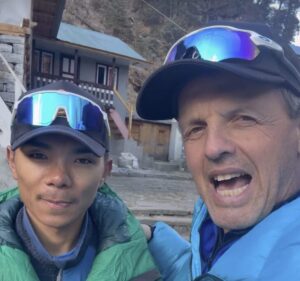The most-discussed aspect of Alex Txikon’s winter K2 expedition did not even take place on that mountain. It was the search-and-rescue operation on Nanga Parbat. Txikon and some others in his team left K2 Base Camp for a nerve-wrecking helicopter flight through a war zone, equipped with a telescope, three powerful drones and only a faint hope of finding Daniele Nardi and Tom Ballard alive, after the pair went missing a week earlier. The following days proved an adventure by itself, with the tragic ending that the mountaineering world knows well by now. Below, Txikon recounts those difficult days.

Alex Txikon discusses Nanga Parbat’s Mummery Spur during a recent talk. Photo: Angela Benavides.
I am sorry to ask this, but when you went to Nanga Parbat, were you looking for bodies or did you really hope to find Nardi and Ballard alive?
At first, I didn’t worry too much: I thought their lack of contact was some communication issue. Nardi had an old Thuraya satphone which often failed. Two days later, I did get worried. By the time we set off, we knew that hopes were really minimal. But we kept alive a spark of hope deep inside. I thought, or made myself think, “What if they are trapped somewhere but with enough fuel to survive for over a week? What if they are clinging to life by a thread?” It would have been a miracle, but a miracle we hoped for. It is hard to explain, and I had hundreds of messages on my cell phone saying we were crazy to risk our lives looking for corpses. Even Ballard’s girlfriend, Stephanie, said she somehow knew Tom was gone. But Nardi’s family was hopeful, and I couldn’t let them down.
Is this why you risked your life, not to disappoint Nardi’s loved ones?
You go because you know it is the right thing to do. And because, honestly, I would very much like someone to search for me in that situation if I went missing. It happened very fast: Dr. Josep Sanchis prepared everything, we grabbed the drones and the telescope, and off we went.

Txikon explains the rescue operation on Nanga Parbat to ExplorersWeb reporter Angela Benavides. Photo: Antonio Fernández
Speaking of risking one’s life, the chopper flight through a restricted area during the conflict with India must have been as risky as Nanga Parbat’s avalanches…
Yeah, that was scary. The area was completely closed and they agreed to let that single chopper fly. But the pilots were very nervous, because they were expecting the Indians to fire at them. They said that hitting a chopper is very easy because it flies so slowly.
It seemed at first that Braun’s expedition was going to handle the rescue operation. What changed?
All options were discussed. I was in contact with several people, including Louis Rousseau from Canada and Agostino da Polenza, a good friend of Nardi’s, who asked Ali Saltoro to arrange sending help to Nanga Parbat. When the Italian Ambassador and Daniele’s brother asked me to go, I said yes.

Tom Ballard (left) and Daniele Nardi had been last reported around 6,300m on Nanga Parbat.
This was Nardi’s fifth attempt on Nanga Parbat. Was he perhaps so eager to climb this nemesis of his that he let his guard down?
Nardi was obsessed with Nanga Parbat and he was stubborn. At the same time, he was no newbie or irresponsible: He knew perfectly well what he was doing. I saw his higer camps: They were neat, perfectly equipped, and ready for a well-planned climb.
But some have said that the Mummery Spur is too dangerous, almost suicidal.
I wouldn’t be so sure. He knew every inch. Look, from my experience there, the route was in fact very dangerous and avalanche-prone in the middle of the day, because the temperature changes brutally on Nanga Parbat. But early in the morning and from late afternoon on, it was okay, nothing fell.
When did you spot the bodies?
On March 5. But when we sent the drone, it suddenly ran out of power and fell out of our reach. We couldn’t approach the bodies because of avalanche risk. We waited till the next morning and spotted them clearly through the telescope.Then we informed the family. We published no pictures. The only one was shared by Ambassador Pontecorvo, and it was purposely blurred to avoid giving too much detail.

Even in the blurred image, they don’t seem to have been swept down by an avalanche.
They were not. From afar, we could see that the rope above them was tight. I can’t tell for sure, but I believe that either they fell, or possibly they were too cold and tired during their descent and they froze when the temperature dropped at sunset. Anyway, it is a tragedy.
Right after returning, I visited Daniele’s family in Italy, and they organized a beautiful tribute ceremony. I don’t know… It made me reflect on so many things. You know, I held his six-month-old baby in my arms. I couldn’t help asking myself whether it is sensible to go to winter Nanga Parbat with such a young baby… But what can I say, it is so sad.






